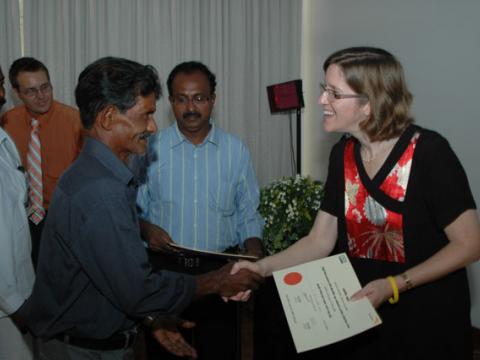Unique agriculture project brings new hope to dry zone farmers

World Vision Lanka held a special Farmer Appreciation Ceremony to mark the completion of its Integrated Farming and Sustainable Agriculture project which has been an outstanding success.
The project helped dry zone farmers establish sustainable farming systems on their own land which they had previously thought was unusable and which now enabled them to earn regular incomes.
A fine example of the Government, Private Sector, INGO and the community working together to improve the living standards of the rural communities in the country, the programme has proved to be outstanding success and worthy of emulation in other localities and by other institutions.
Components of the model include rain water harvesting, live fencing, integrated pest management, low-chemical fertiliser, soil and moisture conservation methods and animal husbandry. Today, four years since the inception of the project, more than 10,000 farmers boast personal farms complete with short-term, medium-term and long-term crops.
Over 80 farmers representing seven districts participated in the ceremony organised by World Vision Lanka. Farmers from Weeraketiya, Galenbidunuwewa, Horowpothana, Kebethigollawa, Giribawa , Thanamalvila, Vellaveli and Pottuvil areas received a certificate and an award from World Vision.
“I want to congratulate the Government of Sri Lanka, the private sector and organisations such as World Vision who have the interests of famers at heart and who work closely with them to bring about such effective results,” said Valerie Fowler, Deputy Chief of Mission of the US Embassy who was the Chief Guest on the occasion.
“The United States Department of Agriculture (USDA) had provided World Vision USD 7.2 million in funding over the last six years and it's not always we get to see the results of our funding in the same way we see them today. It’s very heartwarming,” Fowler added, “I don’t think I have seen a better orange than the oranges I have seen here. Over 40 percent of farmers have shown a Rs. 20,000 (USD 200) increase in their income and that’s absolutely remarkable.”
“I want to commend World Vision for introducing an integrated approach to agriculture and more importantly for ensuring that the funds were used responsibly and in a manner that provided maximum benefits to the project beneficiaries, the farmers,” she said.
World Vision Group Director for Field Operations, Scott Lout said that more than 10,000 farmers had directly benefited from the USDA-funded project. “However, we are finding out that thousands more are replicating what has been learned in this model. They are taking advantage of the various technologies introduced in the project to improve their own farming systems.”
K.Dinapala, a famer from Horowpathana said that lack of knowledge had been a major setback over the years in trying to improve the crop. But through World Vision’s IFSA Projects he has gained a comprehensive knowledge on soil conservation and fertiliser use. “We didn’t have seeds to grow and the seeds we used to cultivate were collected using traditional methods but World Vision’s interventions helped us to obtain the hybrid seeds developed by the Agrarian Department. This has enabled us to yield more harvest,” he said.
World Vision has linked up agriculture farmers with marketing giants like Cargills and the dairy famers with Milco, enabling the rural farmer to bypass the middlemen to obtain a better price for their produce.
Haridas Fernando of Cargills said that the direct linkage between farmer and Cargills has helped the farmer to get a minimum guaranteed price for their produce. “Thanamalvila vegetable collecting center setup by World Vision has linked up 200 farmers in the area and for each kilogramme processed at the center.
There have been some other benefits too for the farmers. For every kilogramme of produce purchased, Cargills has agreed to pay 50 cents to a special farmer welfare fund. The welfare society now has savings of over Rs. one million and has already given scholarships to 29 needy children in the area,” he said.
The project is one of the many diverse initiatives undertaken by World Vision to assist the development of the rural communities of Sri Lanka.
World Vision is a Humanitarian, Development, Relief and Advocacy organisation working with children and their communities regardless of their religion, race, gender or ethnicity. World Vision has been in Sri Lanka since 1977 and has invested over USD 350 million (Rs. 40 billion) in projects spread throughout the country.